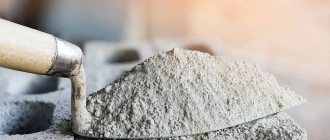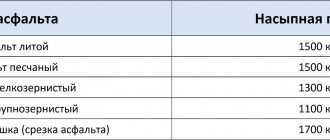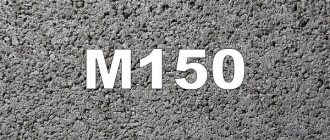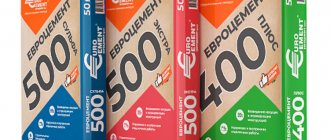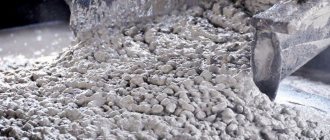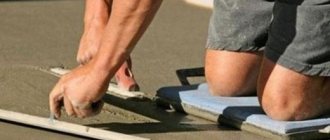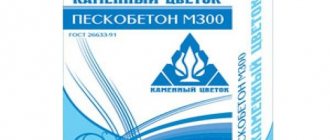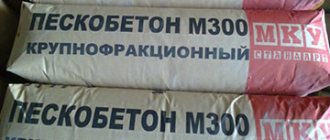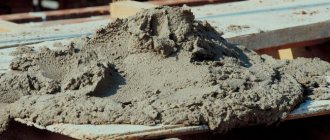The characteristics of sand concrete m300 (composition, proportions 1 m³) are standardized by GOST 7473-94.
High-quality dry mixture contains:
- Portland cement PC500 D20/PTs400 D0;
- fractionated dry sand, with a combined composition of fractions (particle size 0.80-4.0 mm);
- other additives (frost-resistant, microsilica, fiberglass) are introduced at the discretion of the manufacturer.
Depending on the sand used, M300 grade material is used to carry out certain work:
| Sand, particle size, mm | Characteristic | Application |
| Small – 0.80-1.20 | High wear resistance and strength characteristics | Carrying out critical masonry and other external work, light floor screed 50.0 mm, installation solutions of increased strength |
| Average – 1.80-2.20 | Increased resistance to operating loads | Implementation of interior work, laying curbs, paving slabs, erection of Euro fences, screed up to 100 mm, “warm floor” systems |
| Large – 2.50-4.0 | Moderate moisture absorption | Construction of slab, strip and column foundations, plinths, pit floors, without restrictions on thickness using reinforcement |
Characteristics of sand concrete M300
Sand concrete m300 consists of sand, cement, water and plasticizers, without the use of crushed stone. Mortars also have the same composition, so confusion often arises about what is called sand concrete and what is called mortar. There is colossal confusion:
- some factories adhere to the standards of GOST 28013-98 “Construction Mortars”, and use the word “sand concrete” for mixtures without crushed stone with a strength of more than M200 (while M200 and less durable mixtures are called mortars),
- others believe that any mixture without crushed stone is called a solution,
- third - that all mixtures without crushed stone are called sand concrete, not mortar,
- fourth - that sand concrete is concrete with fine crushed stone (3-10),
- and fifthly, both sand concrete and mortar can be of the same brands, and indicate a mixture of coarse and fine sand, respectively.
The word “sand concrete” itself does not appear in regulatory documents (GOSTs and SP), and therefore it can only be certified using technical specifications (TU). So there is no need to say that the correct designation is PBSG M300 P4.
The strength of sand concrete grade M300 means that after laying and hardening, the final stone must withstand a load of 300 kg/cm 2 . This can be checked in the laboratory, for which test samples are cast; there are also non-destructive methods for strength testing.
There are 2 types of sand concrete M-300: ready-made and dry (it would be more correct to say sand concrete mixture M300, because the final sand concrete exists only in one form - hardened stone). The finished mixture is mixed at the factory and transported to the site in the same way as any other mortar or concrete mixture. The dry mixture is sold in bags and mixed directly on site. Due to the difference in presentation, there is an opinion among private individuals that this is the difference between the mortar and sand concrete: that the M-300 solution is supplied to the facility in finished form (in the form of a mixture), and sand concrete is supplied in a dry form (especially that it is written on the bags - “sand concrete M300”), but this is incorrect.
Sand concrete M 300 technical characteristics
According to the current state standard, ready-made dry construction mixtures differ in the specified technical characteristics.
Compound
Any construction sand-concrete mixture is composed of the following components:
- Portland cement;
- sand;
- various additives - modifiers, plasticizers, etc.
For M300 grade materials, Portland cement M500 is used . In addition, the composition of the M300 mixture, the proportions of 1 m³ are as follows - 1/3 cement (acts as a binder) + 2/3 sand (filler).
The introduction of coarse sand into the composition allows the material to obtain a more rigid spatial structure, which is appropriate when conducting foundation work
Frost resistance according to GOST
This parameter clearly shows the ability of the material to withstand alternate repeated thawing and freezing without significant deterioration in strength characteristics and visible signs of destruction. For M300 grade material, frost resistance is at least 50 cycles . This mixture can be used when working in unheated rooms, for example, garages.
Compressive strength
This property allows us to understand what ultimate strength a material has under the influence of dynamic and statistical loads, exceeding which leads to inevitable deformation and destruction.
It is capable of withstanding loads up to 30 MPa . A private builder should know that 1 MPa is 9.81 kg/cm², which is often rounded to 10.00. Thus, the compressive strength of M300 sand concrete corresponds to 300 kg/cm².
Temperature range for work
When conducting construction within the temperature range, strict implementation of all technological processes is observed. The recommended mode for styling is from +5 to +25°C . Very often the builder is forced to break this rule, but then it is recommended to introduce frost-resistant additives into the material, which helps to carry out work without compromising quality down to -15°C.
Adhesion
Simply put, this is the ability of coatings to interact with each other. Sand concrete M300 forms strong adhesion to the base layer, which is equal to 4.0 kg/cm² . This is a fairly high figure for dry construction mixtures. In order for adhesion to be fully realized, manufacturers recommend preliminary preparation of the base on which the material will be laid.
Bulk density
This is the density of a material in an uncompacted state, which takes into account not only the volume of particles, but also the space that appears between them. In private construction, it is better to operate with bulk density; sand concrete M300 in a bag is in exactly this condition ( bulk density 1500 kg/m³ ).
A fresh screed made of sand concrete with coarse sand is less susceptible to shrinkage. This property allows to minimize defects, cracks and deformations
Taking this into account, it is possible to relate the mass and volume of bulk material and draw up the appropriate proportions for construction. For example, with the specified density the volume of material will be 0.67 m³/t. In private construction, a bucket (10 l) is used as a measuring unit, which has a volume of 0.01 m³ and will mix about 15 kg of dry sand concrete.
Sand particle size
Manufacturers produce M300 sand concrete with different sand fractions. This determines the technology for using the working solution:
- small size – up to 2.0 mm – suitable for external plastering, sealing joints;
- medium – 2.0-2.2 mm – suitable for arranging screeds, tiles, borders, etc.;
- large - more than 2.2 mm - used for the construction of foundations and foundations.
Mixture consumption (sand concrete m300 consumption 1 m²)
This is a standard characteristic that shows the consumer what he expects to consume material for arranging a m² of surface, with a layer thickness of 1.00 cm. For M300 grade sand concrete, this figure varies depending on the manufacturer and is 17-30 kg/m² . Accordingly, the lower the expense, the cheaper the work will cost.
In addition, when constructing foundations, an indicator often appears (for sand concrete M300) - consumption per 1 m³, which also varies between 1.5-1.7 t/m³.
Delamination
The characteristic shows the connectivity of the solution in the upper and lower parts. in question has a delamination capacity of no more than 5.0% , which is a standard GOST indicator for this class of substances.
Among other characteristics, the color of the mixture is noted, which should be uniform gray; viability of the finished solution – 2-3 hours; and its humidity is 0.20%.
Some manufacturers indicate the recommended thickness of the layer to be laid. Usually it is in the range of 10-100 mm (Gosta sand concrete). This indicator deserves attention if floor screed or plastering is carried out. When implementing monolithic work, the mixture consumption will increase . In addition, for pouring the foundations, a sand and gravel cushion of at least 30.00 cm is installed.
The standard hardening time for the solution is 24 hours, the surface is completely ready after 28 days , which is typical for all concrete. When working with a material such as sand concrete M300, the instructions for use should become the main guide for the master.
If you mix expanded clay and sand concrete, you can get expanded clay concrete, which can become the basis for making blocks
Material structure
Manufacturers take the selection of proportions seriously, using the latest technologies and developments in material compositions. It is better to maintain the correct ratio, because otherwise it is difficult to get the expected result. Deviation from the correct ratio of components negatively affects the frost resistance, strength and water resistance of concrete. Sand concrete M300 is produced in dry mixtures, sometimes in the form of blocks.
The mixture contains three components: cement, sand and additives. Let's look at the components in more detail.
- Portland cement. A binder formed by grinding gypsum and clinker. First of all, clinker is crushed, then gradually added to gypsum and the desired composition is obtained. For one ton of finished material, 200-250 kg of Portland cement is used.
- Sand. Ordinary clean river sand is suitable. It is cleaned of stones, clay and other unwanted components. But it is better to buy a construction one, it is not only clean, but also corresponds to the required size up to 0.5 mm. The possibility of using sand concrete for various construction purposes is provided by the addition of coarse sand from 3 to 5 mm, sometimes it is replaced with granite chips.
- Supplements Plasticizers, anti-corrosion components, etc. help make M300 sand concrete better and provide the mixture with additional properties. 800 kg are allocated for all dry components, except cement, per ton of finished product.
According to technical indicators, ready-made sand concrete M300 is divided into three types:
- fine-grained, used for adjusting joints and external plaster;
- medium-fraction, used for the manufacture of screeds, paving slabs, poured floors;
- coarse-grained, suitable for pouring foundations.
Return to contents
Application of sand concrete
The cost of sand concrete M300 is relatively low, and its scope is quite wide. That is why the M300 brand is often used in the preparation of masonry mortars, pouring monolithic foundations, armored belts, and the construction of monolithic buildings.
Characteristics of the material that determine its scope:
SNiP provides for a wide range of applications for sand concrete. Very often, builders conditionally divide this material into plaster, masonry, universal, installation and masonry mortar, although in GOST there is no clear division by application anywhere.
Kawabanga! Concrete compaction coefficient during vibration
In the AlfaCem online store you can buy dry mix M300 for the following types of work:
Contact our consultants to select the optimal mixture for the selected type of work. Our company has been supplying construction sites with dry mixes for 15 years, so we are well versed in the needs and requirements of our customers.
Preparation of concrete M300
If there is no dry mixture, then concrete grade M300 can be prepared independently. Here is a description of the composition of M300 concrete:
- Cement M400 – 1 kg.
- Sand – 1.9 kg.
- Crushed stone – 3.7 kg.
If you use M500 cement, then 2.2 kg of sand and 3.7 kg of crushed stone are added to the solution. In the accompanying documents, ready-mixed concrete of this brand is designated either class B22.5 or class B25.
Now about the consumption of materials per 1 m³ of concrete. How much cement is needed for 1 cubic meter of concrete: at the rate of 10 liters, 41 liters of the finished mixture is obtained. That is, it turns out that the cement consumption per cube of concrete is:
- 10 l is 0.01 m³.
- 41 l is 0.041 m³.
- 1/0,041=24,4.
- 0.01x24.4=0.244 m³ or 244 l.
Features of work
When preparing and working with sand concrete mortar, certain rules must be followed, otherwise the positive characteristics of the material will be nullified.
- Preparation of sand concrete consists of correct and proportional mixing of the dry mixture with water.
- After mixing, the solution should stand for up to 10 minutes, then it must be mixed again.
- Use within a few hours before hardening begins.
- Setting will occur in 8 hours, and the product will reach brand strength in 25 - 30 days.
- The calculated ratio of the finished dry mixture and water is approximately 1.7 - 2 liters of water. That is, the weight of a cube of sand concrete in the form of a solution will consist on average of 1.6 - 1.7 tons of dry mixture and 280 - 290 liters of water.
Sand concrete weight
| Name | Density | Weight | ||
| Sand concrete | (g/cm3) | t/m3 | kg/m3 | kg/dm3 |
| 2 – 2,35 | 2 – 2,35 | 2000 – 2350 | 2 – 2,35 | |
When working with sand concrete, you should use a respirator. It is also necessary to strictly follow the rules of storage and transportation so as not to lose the beneficial properties of the material.
Specific gravity
When calculating the consumption of mortar, it is important to take into account the specific gravity of several types of sand concrete 1 m3:
- M 100 and M 150 are the lightest samples;
- M 300 is the most popular medium-weight mixture;
- M 400 and M 500 are the heaviest sand concrete samples.
The weight of sand concrete per 1m3 is indicated in the table below.
What is sand concrete?
Strictly speaking, “sand concrete” is the common name for concrete mixtures of fine-grained concrete (FMC), the main components of which are Portland cement and mixed sand (fraction up to 4 mm), as well as plasticizers and other additives.
Luxury sand concrete has increased strength, mobility and accelerated strength development.
CHARACTERISTICS OF SAND CONCRETE
Sand concrete has the following technical characteristics: gray color, 180 minutes - setting time, frost resistance index - 50, 0.15-0.18 liters of water are required per 1 kg of dry mixture.
This material has quite a lot of advantages. He:
- resistant to corrosion and temperature changes;
- easy to prepare and install;
- has a long service life;
- has high heat and sound insulation characteristics
- inexpensive.
The characteristics of sand concrete M 300 make it possible to distinguish it from other brands.
SAND CONCRETE CONSUMPTION PER 1 M2.
For many people planning renovations, it is very important to know the consumption of building materials. If we are talking about replacing the floor, first of all you need to calculate the consumption of sand concrete for the floor per square meter of screed.
If the surface does not have significant flaws, then the cost of materials on average can be 19-20 kg of sand concrete per 1 m2 with a layer thickness of 1 cm. Sand concrete consumption is calculated for grade M 300.
If the floors are leveled, the consumption of sand concrete may vary; in this case it is difficult to accurately calculate.
When installing heated floors with a layer thickness of 4-5 cm, the amount of mixture is about 72-80 kg per 1 m2. The thickness of the layer in this case depends on the type of floor: infrared, electric or water.
Sand concrete brands
APPLICATION OF SAND CONCRETE IN CONSTRUCTION
Sand concrete is used for:
- brickwork;
- foundation arrangement;
- sealing joints and seams;
- for screeds and floors;
- production of monolithic slabs and sand concrete blocks;
- embedding of reinforced concrete structures.
Production technology
The mixture is produced in factories. The process begins with designing the composition of the sand-cement mixture. Much attention is paid to the quantitative composition of elements (a change in proportions entails a change in the properties of the product).
Based on the existing design, the ingredients that make up the product are mixed. The properties of the future solution are calculated in advance.
- Weighing components (or volumetric measuring).
- Placing ingredients into a concrete mixing device with forced mixing to obtain a homogeneous mixture of elements that differ in viscosity and hardness.
- The mixing process continues until a homogeneous state is formed.
- Packaging of the finished product.
If the technology and transportation rules are followed, the density of M300 sand concrete, viscosity and other physical properties do not change.
How to choose the best sand concrete
The quality of sand concrete products directly depends on the quality of the material. Strength is determined by the brand of Portland cement, and the amount of shrinkage is determined by the sand fraction.
Here are some general selection rules:
What to do if the floor has level differences?
When installing heated floors, a special plasticizing and compacting additive is indispensable, with which it becomes easier to level the floor and obtain a perfectly flat, smooth surface.
Practical use of sand concrete
Of course, M300 sand concrete from different manufacturers has very different mix quality and, accordingly, different product prices. Concrete of well-known brands, such as Stone Flower, Brozex, Etalon M300, uses untarred cement that has undergone additional separation and activation in the mill.
This material absorbs water very well and does not crack after setting, provided that the amount of water used to prepare the solution is in accordance with the instructions for use. In addition, Stone Flower mixtures use components and cements with a low content of aluminum compounds and have increased frost resistance, so they are excellent for use for outdoor work.
Application of sand concrete
Branded cement mixture is selected for concreting coatings with a load of about 250-300 kg/cm².
According to this indicator, M300 is suitable for installing a high-strength, wear-resistant floor in a basement, utility room, technical or residential area. CPS depending on the sand fraction:
There are no restrictions on the thickness of the applied layer if structural reinforcement is used.
Component proportions and DSP consumption
The standard cement composition includes 1 part of Portland cement of the brands PTs400 D0, PTs500 D20 and 2 times more dried sand of standardized fractions. Polymer and mineral additives may be included to improve certain characteristics:
- plastic;
- frost resistance;
- moisture resistance;
- thermal conductivity;
- resistance to abrasive influences.
Fiber and microsilica may be added by the manufacturer.
In terms of efficiency, the consumption of such a mixture per 1 m2 is quite low. As the size of the M300 layer increases, the costs of sand concrete increase:
- for 1 mm of solution application thickness, about 1.7 kg/m2 is used;
- at 2 mm there is an increase to 3.5 kg for the same area;
- for a 10 mm screed you need 22 kg of dry compound per 1 m2.
The exact consumption of M-300 must be looked at on the packaging, since it differs from different manufacturers and can range from 18 to 30 kg/m2. For pouring screeds, higher values are calculated, since its thickness is standardized by SNiPs from 50 mm.
Independent preparation of sand concrete
The proportions of cement and filler depend on the type of structure being constructed:
Price for DSP
Among industrially manufactured DSPs, the following brands are distinguished by their popularity (and low cost):
- Stone Flower;
- Roussean.
The guaranteed high quality of Rusean is also evident in the fact that the declared strength (30.4 MPa) is higher than the standard for the M300 line (30 MPa).
Features of the technological process when pouring a monolith
To create the right base, you need to take into account the weight of the material. So, the rough base weighs within 90 kg/m² - i.e. has a significant mass. At the beginning of work, it is important to analyze the load-bearing capacity of the structure. The most suitable would be a concrete and stone base.
The process of creating a monolith provides for mandatory technological features: layer thickness – from 3cm to 7cm. If the first condition is not met, the structure will crack. Increasing the thickness is not effective for economic reasons and is characterized by high material consumption. The approximate weight of 1 m2 of cement screed is 22 kg. The table below shows the weight depending on the thickness of the screed. Weight of 1 m2 of sand screed depending on thickness
| Thickness of cement-sand screed | Weight m2 of sand screed (kg) |
| 1 cm | 22 |
| 2 cm | 44 |
| 3 cm | 66 |
| 4 cm | 88 |
| 5 cm | 110 |
| 6 cm | 132 |
| 7 cm | 154 |
| 8 cm | 176 |
| 9 cm | 198 |
| 10 cm | 220 |
| 11 cm | 242 |
| 12 cm | 264 |
| 13 cm | 286 |
| 14 cm | 308 |
| 15 cm | 330 |
The basic fill has the following shapes:
When performing work, each form of cement-sand pouring has technological differences and requires careful preparation of the base. Common workflow stages include:
Calculation of the composition and proportions of mortars
In addition to cement and sand, they contain foaming agents. Therefore, the mass of the cube is very low - less than kg. To enhance strength, special plasticizers are added to cellular solutions.
Particularly light types of concrete are used in the production of blocks and slabs with high thermal insulation properties. Their disadvantage is poor frost resistance. Therefore, building elements with a porous structure require mandatory waterproofing.
In the group of heavy solutions there is an internal classification. It is determined by different ratios of components in formulations.
The main advantages of sand concrete M300 Standard and proper work with it
Any construction or repair cannot be done without dry construction mixtures, such as sand concrete M300 Etalon. It has excellent characteristics, so it is suitable for many jobs, which is why it is in great demand today in the building materials market of the Russian Federation and the CIS.
Characteristics
| Water consumption per 1 kg of mixture | 0.14-0.16 l |
| Layer thickness | 30 – 200 mm |
| Permissible temperature for work | +5 +30°C |
| Usability time at + 22°C and 60% humidity | 180 hours |
| Consumption at a layer thickness of 1 mm | 2.2 kg/m2 |
| Density | 2 kg/m3 |
| Sand grain size | 0.1 – 5 mm |
| Humidity | 0,2% |
| Delamination | no more than 5% |
| Storage duration | 6 months |
| Hardening time | 24 hours |
| Frost resistance | 50 cycles |
| Compressive strength | 30 MPa |
| Adhesion | 4 kg/cm2 |
The composition of sand concrete m300 “Etalon” consists of different fractions of sand, additives, plasticizers and low-aluminate white Portland cement, which is the main binder.
Thanks to the correctly selected consistency, this building mixture is universal.
Where is it used?
Etalonstroy mixture is used to make screeds and floors in large residential and industrial buildings, as well as to perform installation and finishing work. High-quality slabs and blocks are made from sand concrete m-300 "Etalon-Stroy".
It is used in the construction of foundations and castings. It is also used in the manufacture and repair of reinforced concrete structures; it is used to fill staircases and garden paths.
It is the basis for expanded clay concrete; it is also used to seal seams.
Instructions for use
Knowing the characteristics of the etalonstroy building mixture, you can understand whether it is suitable for specific types of work. If you choose this sand concrete, you need to know how to use it and what to follow during the work process.
First you need to prepare the surface of the floors, clean them of dirt and be sure to dry them. When there are cracks and deformations on the surface, they need to be eliminated. Before pouring, be sure to wet the surface to be poured.
Then you can start stirring the solution and pouring the surface to be treated.
It is very simple to prepare the solution. The basic instructions for using the standard are on the bags, so this should not be difficult.
You need to pour the dry mixture into a concrete mixer or mixing container with a mixer, then simply pour in the required amount of water and mix the mixture until a homogeneous, plastic consistency is obtained.
Water consumption according to the standard is 1.6-2.0 liters per 10 kg of sand concrete.
You need to work with the prepared solution within 2 hours after mixing. After pouring sand concrete, after 48 hours you can check the strength of the poured surface, but it can be finally measured after one month. In the process of gaining strength of sand concrete, it is necessary to comply with the required ambient temperature conditions. If the air is cold, this process will take longer.
The hardening period and duration of strength gain of sand concrete M300 Standard depends on the air temperature.
Consumption per 1 m2
Sand concrete standard m300 40 kg is intended for indoor and outdoor use. The poured layer can be up to 200 mm. The minimum layer is 30 mm. Sand concrete consumption standard m300 per 1 m2 is 2.2 kg/m2 with a layer thickness of 1 mm.
For a cubic meter of mortar you need 5.5 bags of building mixture. Therefore, we calculate the costs of sand concrete as follows: we multiply 2.2 kg of the mixture by the number of square meters, multiply by the thickness of the layer in millimeters and divide the resulting figure by 40 kg (the weight of one bag).
In this case, about 6 liters of water are spent per bag of dry mixture.
Reviews from experts
The M300 40 kg reviews are almost all positive, mostly left by professional builders, which speaks to the quality of this construction equipment.
Advantages:
- fineness;
- fits well;
- you can make a thick layer;
- lasting;
- cracks and shrinkage do not appear.
Minuses:
Major renovations often require leveling the floor. Today this can be done dry or wet.
For the wet method, the M300 standard is often used. You need to know that the larger the marking of the mixture, the finer its filler granules, while the strength of sand concrete depends on the size of the granules.
The smaller they are, the stronger the screed. But for a regular floor in an apartment you do not need to buy M400 or M500 sand concrete. This is not economically profitable, and there is no point in making a bunker out of an apartment.
Therefore, the best option for sand concrete for screeds is the M300 standard.
But as practice shows, not all technical characteristics that are indicated on bags of sand concrete correspond to real parameters. Sometimes we come across the fact that the M300 brand mixture has very coarse filler.
Recently, for wet screed, we have been choosing etalonstroy sand concrete grade M300. This building mixture meets almost all modern requirements, which is extremely rare these days.
Due to the good proportionality of sand and cement, this building mixture can be mixed with a mixer during the dilution process, while the sand will not settle, and the prepared solution becomes a plastic mass, it spreads well over the coating. But in order for the frozen screed to become strong and durable, when diluting the mixture, you need to fill in the prescribed amount of water.
A very liquid solution will make the screed brittle, and when it dries, cracks will form and shrinkage is possible, and a very thick solution will peel off from the base.
Thanks to the fine grains, this mixture can be used to plaster surfaces, so it is universal. Thanks to this, today sand concrete standard M300 50 kg is in great demand on the market. The manufacturer issues a certificate of conformity for sand concrete standard M300, so it is used in all areas of construction.
From Etalon sand concrete you can make a reliable and high-quality screed with a thickness of more than 10 cm, which will not crack or peel off.
Source: https://betonov.com/vidy-betona/peskobeton/peskobeton-m300-ehtalon.html
Dry mix consumption table
| Brand | Consumption per kg/m2/mm |
| Sand concrete M-300 TsSM | 1.80 |
| Sand concrete M-300 Rusean | 1.80 |
| Sand concrete M-300 RUSEAN LUIX | 1.80 |
| Sand concrete M-300 ECO | 1.80 |
| Sand concrete M-300 Standard | 2.55 |
| Sand concrete M-300 Stone flower | 1.93 |
| Sand concrete M-300 Vilis | 2.25 |
| Sand concrete M-300 De Luxe | 2.25 |
| Dry mixture M-150 PERFEKTA / PERFECTA Universal | 1.90 |
| Dry mix M-150 PERFEKTA / PERFECTA Plaster | 1.90 |
| Dry mixture M-200 PERFEKTA / PERFECTA Assembly | 1.90 |
| Dry mix M-400 RUSEAN Dry concrete | 1.90 |
| Dry mix RUSEAN NC Waterproofing cement | 1.80 |
| Dry mixture OSNOVIT BRICFORM MS11 (T-111) Masonry mortar | 2.00 |
